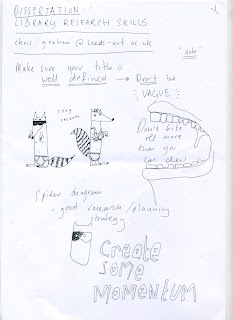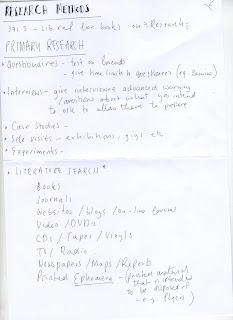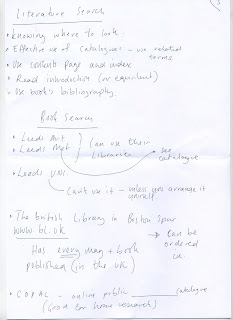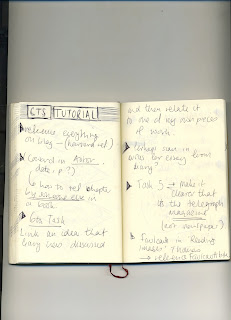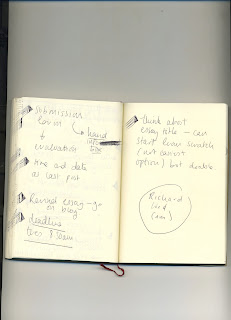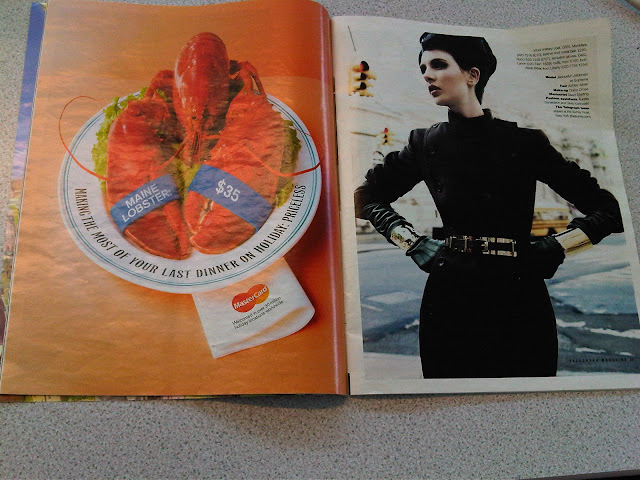“To what extent is a female gaze
possible within patriarchal
visual culture?”
Women have been presented in visual culture in a passive and submissive way for hundreds of years while men have always been the active voyeurs. In a society where 'men dominate overwhelmingly in the production of nearly all popular genres' (
Gamman and Marshment, 1988 p.3). This scopophilic approach to looking at women has become the norm by way of the media and popular culture, while the female gaze appears almost inexistent. This can be supported to some extent simply by the lack of theory relating to an active female gaze. The female gaze, as oppose to the male gaze, is very different in the way that it functions. This male perspective is so dominant within patriarchal society that it makes it very difficult to see a clear female gaze, in terms of women looking at men, or women looking at other women. While contemporary women do participate in the production and distribution of popular media and culture, women seem to continue to be presented in this passive and submissive form. This essay will explore what happens when women are the observer and the concept of the female gaze within patriarchal visual culture; directed at both men and women, and determine how successfully it has been achieved. In order to investigate this idea fully, a good understanding of a male gaze and a thorough exploration into the existence of a female gaze need to be established.
The ‘gaze’ is a term that has long been used to describe how the viewer looks at and understands the person that is in their sight. However, it wasn’t until 1975 that the term ‘male gaze’ was coined by Laura Mulvey in her essay ‘Visual pleasure and narrative cinema’ which was published that year. This term is now freely used as a way of expressing the voyeuristic way in which men look at women; essentially the concept that women are objectified to both a male audience in a sexual context and to a female audience in an envious context. The main theories that are relevant to investigating the concept of a male gaze in are that of John Berger, Laura Mulvey and Roslind Coward, amongst others.
In Berger’s ‘Ways of seeing’ he investigates the way in which people view art and the affects of this on contemporary visual culture and society. His key concept is that ‘Men act and women appear. Meaning that men look at women and women look at themselves being looked at’ (
Berger, 1972, p.47). This indicates that not only are women are objectified for a male audience but also, in Bergers mind, women are aware of the objectification that they are receiving from the male. He also states that ‘From her earliest childhood she has been taught and persuaded to survey herself continually.’ (
Berger, 1972, p.46) Berger is saying that directly from birth woman are aware of their role to satisfy the opposite sex. This could be a result of social pressure from the generation that has brought them into the world. This is not to say that women enjoy being a spectacle of pleasure, but perhaps that they automatically accept the role. Berger illustrates this point, ‘a woman must continually watch herself. She is almost continually accompanied by her own image of herself. Whilst she is walking across a room or whilst she is weeping at the death of her father, she can scarcely avoid envisaging herself walking or weeping.’
(Berger, 1972, p.46) Here he is emphasising that this isn’t necessarily a choice, and that even in a woman’s darkest hour, she will still be concerned by the way in which she is appearing to the onlookers around her. Berger believes that women are ‘depicted in a quite different way to men.’
(Berger, 1972, p64). His reasoning behind this is that ‘the spectator is always assumed to be male and the image of the woman is designed to flatter him’
(Berger, 1972, p.64). Berger’s comment expresses doubt in the idea that the spectator is always male. Largely, Bergers theorizes that men look at women and women watch themselves being looked at. This in turn determines relations between men and women but also women to themselves, ‘The surveyor of woman in herself is male: the surveyed female. Thus she turns herself into an object’
(Berger, 1972, p.47). Berger is suggesting that women are not only objects for male adoration but also for their own.
Jib Fowles is in the same mind as Berger with regards to his theory that this objectified role begins from early in the woman’s life, however he transfers Bergers theory into the context of advertising, ‘In advertising, the gender depiction of the sexes begins early. Males gaze, and females are gazed at.’
(Fowles, 1996, p.204). This is relevant to exploring the concept of a female gaze in more contemporary practice.
Another theorist that explores the gaze in the context of advertising is Dr Paul Messaris author of ‘Visual Persuasions: The Role of Images in Advertising’. Unlike Berger who suggests that women are fully conscious of the male gaze, Messaris suggests that females are both the spectators and the objects and that they ‘treat the lens as a substitute for the eye of an imaginary onlooker.’
(Messaris, 1997, p.41). He concludes that the objectified woman can be aimed at women as well as men.
Another key theory relevant for discussion in this essay is Rosalind Coward. Like Messaris, Coward equally believes that the camera has essentially become 'an extension of the male gaze at women on the street'
(Coward in Thomas, 2000 p.33). She is saying that this omnipresent gaze acts like a mirror constantly reminding them of how they appear to both men and other women. Coward also theorizes that women are not only aware of their own objectification, but also play up to it in order to 'lure men to a terrible fate - monogamy and the marital home'
(Coward in Thomas, 2000 p. 34). This is perhaps the most extreme perspective of all the theories discussed so far, but particularly relevant when beginning to investigate the presence of a ‘female gaze’. Another point that Coward explores is the notion that men are very much in charge of this gaze and by not allowing themselves to be gazed at in the same way allows them to assert their 'control of desire and the activity of looking' (
Coward in Gamman and Marshment, 1988 p.46).
This links to Laura Mulvey’s theory that the male could not tolerate being objectified, saying that ‘according to the principles of the ruling ideology and the physical structures that back it up, the male figure cannot bear the burden of sexual objectification. Man is reluctant to gaze at his exhibitionist like. ‘
(Mulvey, 2009, p.21) Mulvey suggests that this allows the male possess complete power, taking on an active role as oppose to a passive one. Mulvey has similar ideas to Berger with regards to the appearance of women being tailored for the visual pleasure and satisfaction of men. She says that the male gaze 'projects its fantasy onto the female figure, which is styled accordingly'
(Mulvey, 2009 p.19). However Mulvey does not share Bergers view that women are very aware of their objectification, and says ‘in a world ordered by sexual imbalance, pleasure in looking has been split between active/male and passive/female. The determining male gaze projects its fantasy onto the female figure, which is styled accordingly. In their traditional exhibitionist role women are simultaneously looked at and displayed, with their appearance coded for strong visual and erotic impact so that they can be said to connote to-be-looked-at-ness...’
(Mulvey, 2009, p.19). This concept of an active male and the passive female is significant to Mulvey’s gaze theory and extremely important in the investigation of a ‘female gaze’.
Although differing in opinions, all of these theorists concur on the concept that women are being displayed in front of men which makes it difficult to dispute. With an understanding of the theorization of a male gaze, it will be easier to investigate the possibility of a female gaze.
After Mulvey’s introduction of the male gaze in 1975, the ‘female gaze’ theory arose in conjunction with the second wave of feminism. As Coward says; ‘Feminism had given the woman the confidence to move into masculine areas, combining work and motherhood, seeing new opportunities in new work patterns. Men, by contrast, were experiencing their work changes, this so-called feminization of labour, more like a smack in the eye’
(Coward, 1999, p.66) This was not just a change in the way males were perceived, but also the perception of women was changed. Women were no longer just the submissive housewives and mothers they had been.
Between then and now there has been a huge change due to women having careers and a huge increase in the ‘male market’ while men gradually become more and more self conscious and following fashions. By the end of 1998 male market worth £560 million a year which was the biggest growth in sales for the European cosmetic industry during the 1990’s. In today’s modern society, it is not just men what look at women, but also women who look at women, not just in a sexual way. They aspire to look like other women, following fashion and children look up to the generation of women above them.
Initially, it is necessary to investigate the theory of an active female gaze in which men are objectified rather than women. In this instance the man becomes passive, whilst the female is the voyeur. This difference in the way that women choose to present men for women's visual consumption in comparison to the way that men choose to completely objectify women in the equivalent industry suggests that men are asserting their 'control of desire and the activity of looking'
(Coward in Gamman and Marshment, 1988 p.46). This suggests a fear of loosing control of the asymmetric power gender relationship between men and women.
An interesting example of this is erotic magazine 'Filament', self-proclaimed through the tagline as 'The thinking women's crumpet' (
www.filamentmagazine.com). This magazine is not only aimed at women but is also produced by women. The existence of this magazine illustrates Cowards point that feminism gave women ‘the confidence to move into more masculine areas’
(Coward in Dench, 1999, p.66). Also, unlike other publications of this nature Filament includes articles and discussions non-sex related in an attempt to replicate the way that some men’s pornographic magazines do.

At first glance, this cover for the magazine features a far more sexually subdued image in comparison to say the cover of a men’s pornographic magazine, which usually features a lot more nudity. In addition to this, I think that the models body type is significant. He is not a typical Adonis with rippling muscles. Mens magazines tend to use models with accentuated physical characteristics, while Filament don't always choose this option. Looking through back catalogues of covers, it is clear that the body type of the model varies enormously. However there is still certainly a huge amount of objectification of the male form. Firstly the models face is not shown, making it even less personal and more about his body. This could be interpreted in more than one way; that the photographer is trying to objectify the male body as much as possible, focusing on his body rather than having a personal connection between him and the viewer. Alternatively, this could be a way of maintaining the gender power relationship; while the man isn't allowed to connect directly with the viewer in the same submissive and doe-eyed way that men's pornography does, he remains in control of the situation. This may seem peculiar that a woman-run magazine would want to portray a man in this way, but it could be that women are so used to being gazed at that the idea of the man staring directly out of the image would be uncomfortable and intimidating to the female spectator. This awkward and unfamiliarity in looking at the male form in this way could also be supported by both Mulvey and Cowards shared idea that men don’t allow themselves to be objectified in this way in order to remain in control and their gaze active rather than becoming passive like the female. Ultimately this image is extremely voyeuristic, but not in the same way that that women are essentially presented for male visual consumption as in the case of a men's magazine. This could suggest that women prefer this subtler, less aggressive way of seeing. Another interesting characteristic is the choice of setting for the model. The composition is set in a casual domicile environment. This along with the active gesture of the models arm gesturing fondly outside of the main composition implies that there is more than one person in the room. In light of his casual nudity it would be fair to say that the setting implies that there is only one other person present, potentially a wife or girlfriend. The props within the composition are extremely relevant in terms of what they are suggesting to the viewer; the wine glass not only suggests that this is a relatively sophisticated man and also suggests an indication of class and ultimately wealth. This reiterates the previous point with regards to Cowards theory that women fantasize about the ideal of a loving husband and that acting suggestively and submissively is simply a way of attracting attention and a route to getting what they really want; monogamy and marriage.
The final observation relating to this cover is the design decisions made in relation to type and layout. The image fills the entire cover with very little supporting type or other information. The use of dramatic ligatures in the title font makes it extremely flamboyant and the color palette is fairly muted with an element of intensity enforced by the large areas of darker colours. The cover is essentially very artistic and romanticized rather than loud, bright and eye catching like men’s magazines of this nature tend to be.
This evidences suggests a strong and independent female gaze succesfully, however the size and scale of the women's pornography industry by comparison to the men's could create the argument that this gaze is somewhat insignificant. It is by comparison a niche market. The difference in the way that women choose to present men for women’s visual consumption in comparison to the way in which men objectify women for magazines aimed at men of the same theme means that men remain in control of desire and the activity of looking; so women remain passive and men remain the active gazers.
In contemporary society, 'men and women get their dominant definitions of themselves through popular culture'
(Gamman and Marshment, 1988 p.2) which in turn suggests that the feminine ideals presented by women's magazines are indirectly created by men through the overpowering active male gaze. In addition to this; women, much more so than men, are constantly reminded of how they appear to each other and the opposite sex by the constant visual reminders in the media. This supports the theory reflected by Berger and Coward; that this omnipresent gaze acts like a mirror constantly reminding them of how they appear to both men and other women.
Therefore, the second idea that I want to discuss relates to Messaris’s theory that objectified women can be aimed at women as well as men; that of an active female gaze where women are looking at women and women are being presented to consumerist culture for women's visual pleasure rather than men’s. Women's magazines claim to present ideals and images of women for this very purpose, which is why my second image for discussion is a front cover of a typical and immensely popular women's' fashion and lifestyle magazine 'Glamour'.

Again the target audience is women, and the gaze, female. The reason I chose this particular cover is because it features pop star singer Rihana as the featured celebrity. I think that this provokes an interesting discussion when put into context alongside her very public private life; this magazine was published not long after her boyfriend Chris Brown was convicted of hitting Rihana. This cover features Rhiannon allegedly opening up to the readers about what happened now that she is 'Stronger and wiser'. This ultimately indicates that Rihana is standing up for herself against her oppressor and essentially giving him the metaphorical finger. However this image of Rihana complies with the ultimate men's ideal of a woman, supporting Berger’s theory that the spectator is always assumed to be male. Her outfit is tight fitting and extremely revealing in favor of her undeniable feminine assets. Both her facial expression and the way in which her head is tilted to once side is quite coy and flirtatious rather than giving off any impression of power and control. This could be argued that she is being presented indirectly through the male gaze and appears completely passive. In a patriarchal society, how a woman sees and reflects herself ultimately connotes her success in life. The way that Rihana is presented in this image, in this seductive and submissive way, actually suggests her availability to other men, perhaps to spite her previous partner. This undoubtedly supports Berger’s theory that women are very much aware of the objectification that they receive and Cowards idea, that they play up to the stereotype that is expected of them. Some other interesting elements to this magazine cover are the featured articles. "7 reasons guys love you just the way you are" for example, appears to be quite a positive theme for an article aimed at young women. It appears to promote positive self-image and demote the idea of changing yourself to live up to the ideals created by the male gaze. However, the fact that the reason you should feel empowered to love yourself, is that men will love you just the way you are, rather than you feeling positive about yourself for your own benefit, which is ultimately completely contradictory of the female gaze. Another article title that grabs my attention is 'How to eat, drink and not gain weight'. The female ideal of a voluptuous yet athletic and trim feminine physique was created by the active male gaze, but this magazine aimed at women, supposedly instigating a positive female gaze, is encouraging living up to a sexist stereotype. The most interesting thing about this magazine is that the editor, Jo Elvin is female. It is not men who are promoting that women should live up to these ideals, it is women. In summary, it seems that both the female consumer and the women attempting to present an active female gaze are actually encouraging self regulation, encouraging women to aspire to the image created by the male gaze.
Perhaps in the past, it would be fair to say that men had a huge amount of dominance over the media industries and in turn had a lot of influence over the way that women were presented, based on an active male gaze. However, I think that is incredibly important to understand that in contemporary society, it is not just men who are promoting these 'socially prescribed ideals'
(Coward in Thomas, 2000, p.33), it is women as well. Not only do women automatically self-regulate themselves to conform to these ideals based on constant visual reminders in the media that is lead by men, but also, if not more so from areas of the media controlled by women. The more that women are presented or present themselves in this essentially submissive way, the more that it becomes 'normal' within our society. This pushes women to loose sight of what is actually real, and find themselves trying to live up unrealistic ideals in a kind of hyper reality. Ultimately, men created this male ideology, but it is certainly instigated by women.
Bibliography
Books
Berger, J. (1972)
Ways of Seeing, London, Penguin
Betterton, R. (ed) (1987)
Looking on : Images of Femininity in the Visual Arts and Media, London, Pandora Press
Coward, R. (1999)
Was Feminism wrong about the Family? In Dench,G.
Rewriting the sexual contract, London, Transaction Publishers
Dotter, R. and Bowers, S. (1992)
Sexuality, the Female Gaze, and the Arts, Cranbury, Associated University Presses
Fowles, J. (1996)
Advertising and Popular Culture, London, Sage Publications
Gamman, L. and Marshment, M. (eds) (1988)
The Female Gaze, London, The Woman’s Press
Gill, R., (2006)
Gender and the Media, Chichester, Polity Press
Mulvey, L., (2009)
Visual and other pleasures, Basingstoke, Palgrave Macmillan
Messaris, P. (1997)
Visual Persuasions : The Role of Images in Advertising, London, Sage Publications
Nochlin, L. (1999)
Representing Women, Singapore, C.S.Graphics
Sanroman, S. (2009)
Women Looking at Women : The Female Gaze, Germany, VDM Verlag
Thomas, J. (ed) (2000)
Reading images, Basingstoke, Palgrave Macmillan
Websites
http://www.filamentmagazine.com/Home.aspx (31/01/11)


